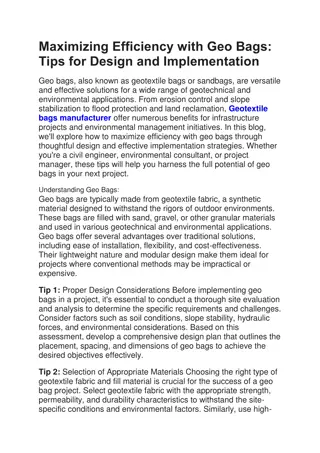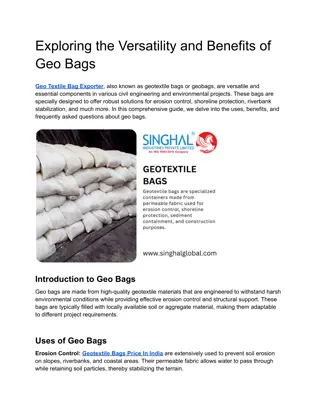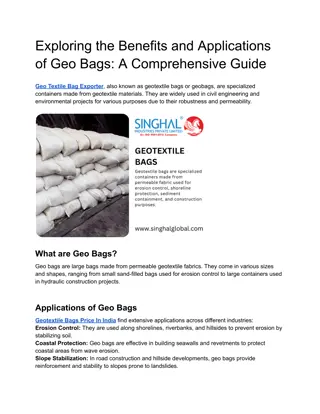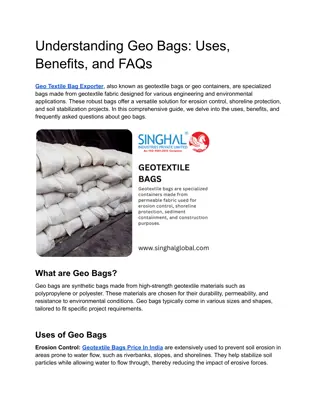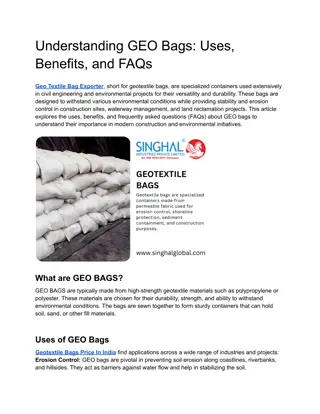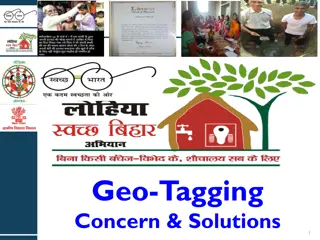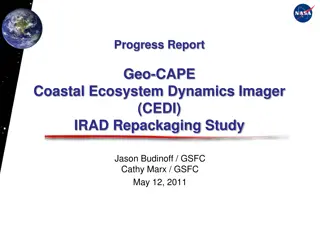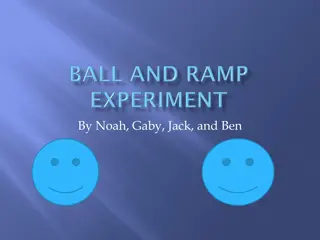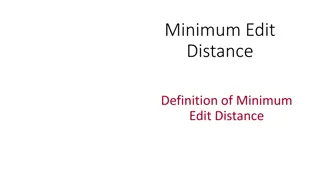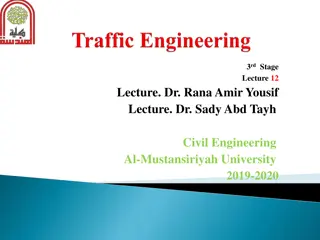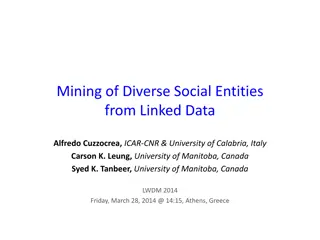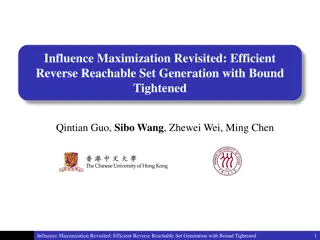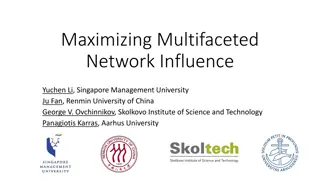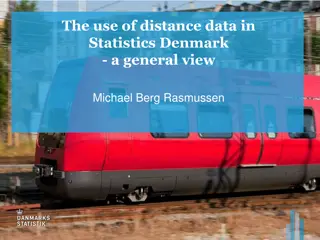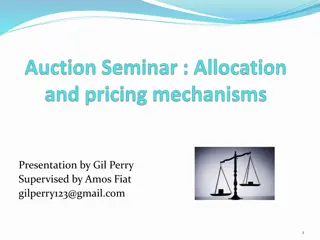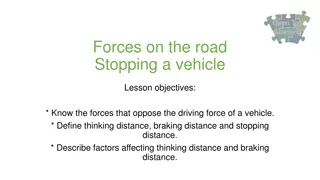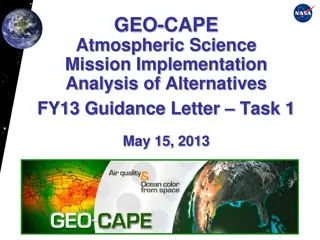Distance-Aware Influence Maximization in Geo-Social Networks
This study explores the Distance-Aware Influence Maximization in Geo-social Networks by XIAOYANG.WANG1, YING.ZHANG1, WENJIE.ZHANG2, XUEMIN.LIN2 from universities in Australia. The research delves into the concept of influence maximization, social network platforms, word-of-mouth impact, and location-aware influence maximization in platforms like Foursquare and Twitter. The paper defines the problem in a geo-social network setting, discussing the diffusion model and influence spread, with a focus on finding nodes to maximize the influence spread.
Download Presentation

Please find below an Image/Link to download the presentation.
The content on the website is provided AS IS for your information and personal use only. It may not be sold, licensed, or shared on other websites without obtaining consent from the author.If you encounter any issues during the download, it is possible that the publisher has removed the file from their server.
You are allowed to download the files provided on this website for personal or commercial use, subject to the condition that they are used lawfully. All files are the property of their respective owners.
The content on the website is provided AS IS for your information and personal use only. It may not be sold, licensed, or shared on other websites without obtaining consent from the author.
E N D
Presentation Transcript
Distance-Aware Influence Maximization in Geo-social Network XIAOYANG WANG1, YING ZHANG1, WENJIE ZHANG2, XUEMIN LIN2 1. UNIVERSITY OF TECHNOLOGY SYDNEY, AUSTRALIA 2 . UNIVERSITY OF NEW SOUTH WALES, AUSTRALIA
Outline Introduction Preliminaries Pruning Rules and Algorithm Experiments Conclusion 2
Introduction Social Networks Social network platforms 3
Introduction Social Networks Social network platforms Word-of-mouth in social network Influence Maximization xpad is good xpad is good xpad is good xpad is good 4
Introduction Geo-social Network (Foursquare, Twitter) 5
Introduction Geo-social Network (Foursquare, Twitter) Location Aware Influence Maximization [1] [1] G. Li, S. Chen, J. Feng, K. Tan, and W. Li. Efficient location-aware influence maximization. In SIGMOD 2014 6
Introduction Geo-social Network (Foursquare, Twitter) Location Aware Influence Maximization [1] [1] G. Li, S. Chen, J. Feng, K. Tan, and W. Li. Efficient location-aware influence maximization. In SIGMOD 2014 7
Introduction Geo-social Network (Foursquare, Twitter) Location Aware Influence Maximization [1] 10 2 0.5 10 10 1 [1] G. Li, S. Chen, J. Feng, K. Tan, and W. Li. Efficient location-aware influence maximization. In SIGMOD 2014 8
Problem Definition Data Geo-social Network G = (V, E) Each node has a location; each edge has a probability. Diffusion Model (Independent Cascade Model) xpad is good xpad is good 0.4 xpad is good 0.3 0.5 xpad is good 0.6 0.2 9
Problem Definition Data Geo-social Network G = (V, E). Each node has a location; each edge has a probability. Diffusion Model (Independent Cascade Model) Influence Spread The expect number of nodes activated in the process. ? ? = ? ??(?,?) Traditional Influence Maximization Find a set of k nodes that maximizes the influence spread. 10
Problem Definition Distance-aware Influence Maximization Given a query location ?; A weight function: ? ?,? = ? ? ??(?,?); Find a set of k nodes that maximizes the distance aware influence spread: ??? = ? ?? ?,? ?(?,?) Hardness of the Problem Calculate ??? is #P-Hard. The Distance-aware influence maximization is NP-Hard. 11
Preliminary MIA Model [2] A node can influence another node only through the maximal influence path. 2 3 1 0.5 0.8 1 4 0.5 0.5 0.5 6 5 [2] W. Chen, C. Wang, and Y. Wang. Scalable influence maximization for prevalent viral marketing in large-scale social networks. In KDD 2010 12
Preliminary MIA Model [2] A node can influence another node only through the maximal influence path. 2 3 1 0.5 0.8 1 4 0.5 0.5 0.5 6 5 [2] W. Chen, C. Wang, and Y. Wang. Scalable influence maximization for prevalent viral marketing in large-scale social networks. In KDD 2010 13
Preliminary MIA Model [2] A node can influence another node only through the maximal influence path. The probability of the maximal influence path should be larger than a threshold t (e.g., 0.4) 2 3 2 3 1 1 0.5 0.8 0.5 0.8 1 4 1 4 MIOA(?1) 0.5 0.5 0.5 0.5 6 6 5 [2] W. Chen, C. Wang, and Y. Wang. Scalable influence maximization for prevalent viral marketing in large-scale social networks. In KDD 2010 14
Preliminary MIA Model [2] A node can influence another node only through the maximal influence path. The probability of the maximal influence path should be larger than a threshold t (e.g., 0.4) 2 3 2 3 1 1 0.5 0.5 0.8 0.8 1 4 1 4 MIIA(?4) 0.5 0.5 0.5 0.5 6 5 5 [2] W. Chen, C. Wang, and Y. Wang. Scalable influence maximization for prevalent viral marketing in large-scale social networks. In KDD 2010 15
Greedy Algorithm Hardness under MIA Model Under MIA model, the problem is still NP-Hard. 16
Greedy Algorithm Hardness under MIA Model Under MIA model, the problem is still NP-Hard. Property Submodular and monotonic. Greedy algorithm with (1-1/e) approximation ratio. 17
Greedy Algorithm Hardness under MIA Model Under MIA model, the problem is still NP-Hard. Property Submodular and monotonic. Greedy algorithm with (1-1/e) approximation ratio. Problems in Baseline Greedy Algorithm We need to calculate the influence or marginal influence for all nodes in each round. To Speedup Avoid the calculation for less important nodes. 18
Pruning Rules Suppose we can efficiently estimate: ?(?) and lower bound ?? distance-aware influence ??(?) ; ?(?|?) of a node ? ? marginal influence ??(?|?). ?(?) of a node ? ? the upper bound ?? The upper bound ?? Rule 1. ?(?) or ?? ?(?) ?? ?(?), we For the first seed selection, if ?? ? ?? can prune ?. Rule 2. ?(?) or For the subsequent seed selection, if ?? ?|? ?? ??(?|?) ?? ?(?|?), we can prune ?. 19
Pruning Rules Suppose we already have a set ? of ? nodes, which has large distance-aware influence, ? = ?1,?2, ,??. Rule 3. When selecting the ith nodes, a node can be pruned if it is not better than ??. If ? has an approximation ratio of ? 1 1/? , then we can terminate if we can find a seed set with influence ??? /?. 20
Derive Pruning Rules Rule 1. Upper bound and lower bound of influence. Anchor point --- ??? = {???? | ? ?}. ?? = ??? ? exp( ??(??,?)) ?? ?1 ?2 ?? = ??? ? exp(??(??,?)) ?? ? ?3 For node with small influence, a loose bound is enough to prune it, e.g., node with 0.1 influence. ?5 ?4 ?6 For nodes with large influence, a loose bound will result a lot of candidates. 21
Derive Pruning Rules Rule 1. Upper bound and lower bound of influence. Anchor point --- ??? = {???? | ? ?}. ?? = ??? ? exp( ??(??,?)) ?? ?? = ??? ? exp(??(??,?)) ?? ? For node with large influence. ? ?? = ?? ? ?,? ? exp( ??min(?,?)) ? ?(?) ?? = ?? ? ?,? ? exp( ??max(?,?)) ? ?(?) 22
Derive Pruning Rules Rule 1. Upper bound and lower bound of influence. Anchor point --- ??? = {???? | ? ?}. ?? = ??? ? exp( ??(??,?)) ?? ?? = ??? ? exp(??(??,?)) ?? ? By extending the idea of anchor point, we can obtain the seed set ? used in the Rule 3. ? 23
Derive Pruning Rules Rule 2. Upper bound of marginal influence. For nodes with small influence. ??|?,? = ?? ?,? 1 ? ?,? ?? 2 3 1 0.5 0.8 ??|? = ??|?,? ?? ? ????(?)?? 1 4 0.5 For nodes can with large influence, the estimation cost will be large. 6 We partition the MIOA of these nodes to get a coarse-grained estimation. 24
Best First Algorithm Offline Compute the index needed for the pruning rules. Online (k = 2). ?? and ?? ?? for ? ?. Estimate the ?? Calculate exact influence of ? = {?6,?7}. ? = {} ?1 (10, 20) ?6 (15, 15) L = 15 ?2 (5, 15) ?7 (8, 8) ?3 (5, 10) . Q H 25
Best First Algorithm Offline Compute the index needed for the pruning rules. Online (k = 2). ?? and ?? ?? for ? ?. Estimate the ?? Calculate exact influence of ? = {?6,?7}. ? = {} ?2 (5, 15) ?1 (10, 20) L = 15 ?3 (5, 10) ?6 (15, 15) ?8 (4, 5) ?7 (8, 8) . Q H 26
Best First Algorithm Offline Compute the index needed for the pruning rules. Online (k = 2). ?? and ?? ?? for ? ?. Estimate the ?? Calculate exact influence of ? = {?6,?7}. ? = {} ?2 (5, 15) ?1 (18, 18) L = 18 ?3 (5, 10) ?6 (15, 15) ?8 (4, 5) ?7 (8, 8) . Q H 27
Best First Algorithm Offline Compute the index needed for the pruning rules. Online (k = 2). ?? and ?? ?? for ? ?. Estimate the ?? Calculate exact influence of ? = {?6,?7}. ? = {?1} ?2 (5, 15) ?1(18, 18) L = 15 ?3 (5, 10) ?6 (15, 15) ?8 (4, 5) ?7 (7, 7) . Q H 28
Best First Algorithm Offline Compute the index needed for the pruning rules. Online (k = 2). ?? and ?? ?? for ? ?. Estimate the ?? Calculate exact influence of ? = {?6,?7}. ? = {?1} ?2 (5, 15) ?6 (~, 7) L = 7 ?3 (5, 10) ?7 (7, 7) ?8 (4, 5) . Q H 29
Best First Algorithm Offline Compute the index needed for the pruning rules. Online (k = 2). ?? and ?? ?? for ? ?. Estimate the ?? Calculate exact influence of ? = {?6,?7}. ? = {?1} ?8 (4, 5) ?2 (5, 15) L = 7 ?9 (3, 5) ?3 (5, 10) ?10 (2, 4) ?7 (7, 7) ?6 (~, 7) . Q H 30
Best First Algorithm Offline Compute the index needed for the pruning rules. Online (k = 2). ?? and ?? ?? for ? ?. Estimate the ?? Calculate exact influence of ? = {?6,?7}. ? = {?1} ?8 (4, 5) ?2 (~, 9) L = 7 ?9 (3, 5) ?3 (5, 10) ?10 (2, 4) ?7 (7, 7) ?6 (~, 7) . Q H 31
Best First Algorithm Offline Compute the index needed for the pruning rules. Online (k = 2). ?? and ?? ?? for ? ?. Estimate the ?? Calculate exact influence of ? = {?6,?7}. ? = {?1} ?8 (4, 5) ?3 (~, 6) L = 7 ?9 (3, 5) ?2 (~, 9) ?10 (2, 4) ?7 (7, 7) ?6 (~, 7) . Q H 32
Best First Algorithm Offline Compute the index needed for the pruning rules. Online (k = 2). ?? and ?? ?? for ? ?. Estimate the ?? Calculate exact influence of ? = {?6,?7}. ? = {?1} ?8 (4, 5) ?2 (8, 8) L = 7 ?9 (3, 5) ?7 (7, 7) ?6 (~, 7) ?10 (2, 4) ?3 (~, 6) . Q H 33
Best First Algorithm Offline Compute the index needed for the pruning rules. Online (k = 2). ?? and ?? ?? for ? ?. Estimate the ?? Calculate exact influence of ? = {?6,?7}. ? = {?1, ?2} ?8 (4, 5) ?2(8, 8) L = 7 ?9 (3, 5) ?7 (7, 7) ?6 (~, 7) ?10 (2, 4) ?3 (~, 6) . Q H 34
Experiments Algorithms PMIA: based on MIA model. CELF++: greedy algorithm. PRI : Best first search algorithm with pruning rule 1. PRII : Best first search algorithm with pruning rule 1, 2. PRIII: Best first search algorithm with pruning rule 1, 2, 3 Dataset Property Brightkite Gowalla Twitter # nodes 58K 197K 554K # edges 428K 1.9 million 4.29 million Edge probability Weighted model: 1/??????; Trivalency model: edge probability is randomly selected from {0.1,0.01,0.001}. 35
Experiments 36
Experiments 37
Conclusion Investigate the problem of distance aware influence maximization. Propose three pruning rules to accelerate the nodes selection. Propose the best first algorithm combined with the pruning rules. 38
Thanks! Q&A 39


